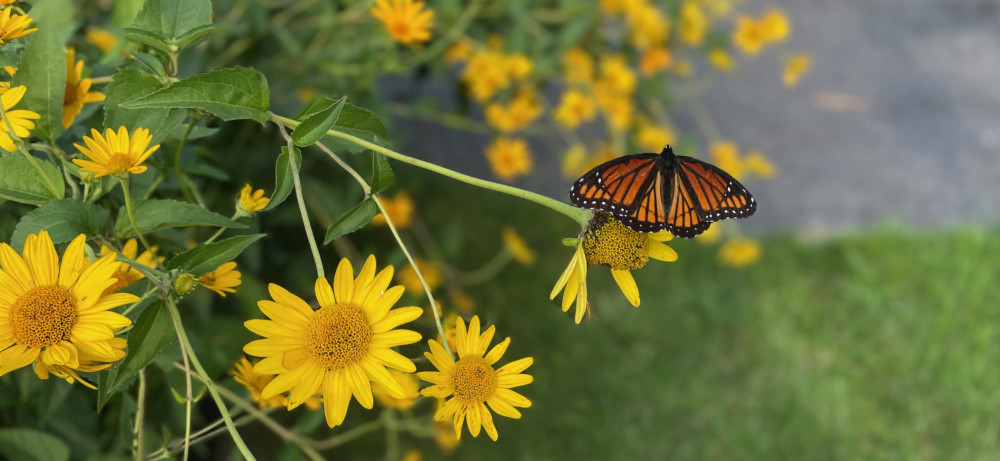Crossover Goals: Pollinator Garden Signage
The interpretive signs in the Purchase Native Pollinator Garden resulted from collaboration between environmental studies, arts management, and graphic design.
The Purchase Native Pollinator Garden, tucked away in a tranquil stretch of grass behind the Dance Building, serves many purposes to the campus community and to the ecosystem.
It’s a “pitstop” for the Monarch butterfly on its annual 3,000-mile migration to Mexico. Multiple species of the milkweed plant here attract and nourish them, according to a sign installed at the garden’s center. The garden’s signage is a veritable demonstration of the crossover learning opportunities available at Purchase.
Experiential and Interdisciplinary
Ripe for collaboration between the arts and the sciences since its inception in 2019, the Purchase Garden was the focus of a recent cross-departmental project when students in Environmental Studies and Arts Management collaborated to curate and create interpretive sign concepts. Allyson Jackson, assistant professor of environmental studies and Melissa Forstrom, assistant professor of arts management, joined forces to offer this unique opportunity.
Students in Jackson’s Conservation Biology class focused on native plants, the global biodiversity crisis, and best practices for science communication to the public, while those in Forstrom’s Exhibition Practice and Management class covered analyzing best practices for exhibition interpretation. They learned from each other as they merged their expertise to conceive of effective interpretative strategies for multiple audiences.
Each team produced a concept, selected the finalist, then worked with Alex Klercker ’23, a Graphic Design major, who visually interpreted their ideas into designs—a 24x36” introduction panel, an 18x24” panel focused on Monarch butterflies, and a 10x12” acknowledgement sign.
With grant funding to produce and install the signs, the students also gained project management experience, from budgets to installation.
Fulfilling Aspirations
The multipurpose intentions behind the Pollinator Garden included roles in the environment, campus life, community engagement, and curriculum. The signage project truly brought the latter to life. According to Jackson, “It really fit in with the goals of the garden as a place to learn but also to have students working side by side with faculty.”
The introductory panel reads, “This small plot here at Purchase is a part of a larger mission to create a more sustainable world and help combat climate change.”
Beyond those lofty goals, it provides students a sense of community and connection to nature every time they volunteer to plant seeds, pull weeds, or paint picnic tables. Not to be overlooked is the respite it provides from life’s daily demands.
And the abundance of bees and butterflies on a recent summer afternoon proves the garden’s worth to the ecosystem—human survival relies on bees. Even a small pollinator garden helps preserve them. Learn more and #savethebees.
